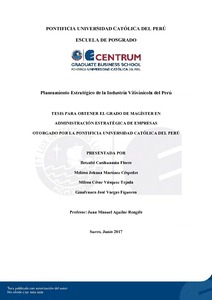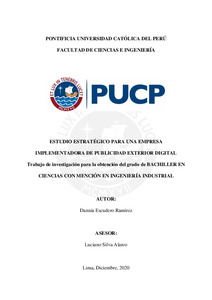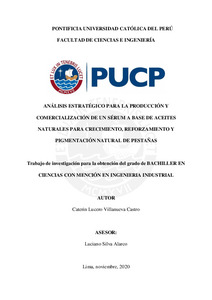| dc.contributor.advisor | Aguilar Rengifo, Juan Manuel | |
| dc.contributor.author | Cusihuamán Flores, Betzabé | es_ES |
| dc.contributor.author | Martínez Céspedes, Melissa Johana | es_ES |
| dc.contributor.author | Vásquez Tejada, Milton César | es_ES |
| dc.contributor.author | Vargas Figueroa, Gianfranco José | es_ES |
| dc.date.accessioned | 2017-07-17T23:10:25Z | |
| dc.date.available | 2017-07-17T23:10:25Z | |
| dc.date.created | 2017 | |
| dc.date.issued | 2017-07-17 | |
| dc.identifier.uri | http://hdl.handle.net/20.500.12404/9066 | |
| dc.description.abstract | La presente investigación tiene como objetivo aportar a la competitividad de la oferta
de vinos peruanos, buscando obtener una mayor calidad del producto. Sobre todo, que la
industria vitivinícola logre diferenciarse frente a sus competidores, todo ello a través del
desarrollo de nuevas cepas, logrando incrementar su variedad en el Perú, que en la actualidad
solo tiene 30 variedades, a diferencia de España, que cuenta con 235, o Uruguay, con 74.
Para alcanzar los objetivos, primero es importante conocer el origen del vino, el
origen de la actividad vitivinícola se remonta a más de 5.000 años a.C. en Oriente Medio y en
el sector más oriental del mar Mediterráneo. En este espacio se desarrollaba una agricultura
muy fértil gracias a su clima cultivándose los tres productos básicos: trigo, vid y olivo. La
existencia de testimonios gráficos en el área de Mesopotamia, así como en la localidad iraní
de Ghani Surshta en el tercer milenio a.C. muestran las primeras apariciones del cultivo de la
vid en la civilización al aparecer vasijas con restos de elementos similares a los producidos
por el vino, además de otros recipientes con una especie de cuello estrecho y alargado muy
utilizado para el traslado de líquidos (Unwin, 2001).
El vino que se consumía en esta época comenzó siendo un producto destinado a una
clase social con un poder adquisitivo muy elevado como eran los faraones, los sacerdotes o
los altos funcionarios. Siglos después se generalizó y se convirtió en una bebida básica en la
dieta debido al aporte nutricional que poseía, además de otros usos como fármaco o remedio
curativo (Sanz, 2009) | es_ES |
| dc.description.abstract | The present research aims to contribute the competitiveness of the Peruvian wine
supply, seeking to obtain a higher quality of this product. Above all, the wine industry can
differentiate itself against its competitors, all through the development and increasing the
variety of strains in Peru. Peru have 30 varieties of strains, less than Spain´s variety with 235
and Uruguay with 74.
The origin of wine-growing activity dates back over 5,000 years BC. In the Middle
East and in the most Eastern sector of the Mediterranean Sea. In this space develops a very
fertile agriculture thanks to its Mediterranean climate cultivating the three basic products:
wheat, vine and olive. The existence of graphic testimonies in the area of Mesopotamia, as
well as in the locality of Ghani Surshta in the third millennium A.C. To show the first
occurrences of grapevine cultivation in the civilization, apparently, vessels with liquid
remains similar to those produced by wine, as well as other containers with the species of
narrow and elongated neck widely used for the transfer of liquids (Unwin, 2001).
The wine that is consumed in this time is in a determined destination and is a social
class with a very high purchasing power as it was in the states, the priests and the high
officials. Centuries later, it became generalized, and became a staple in the diet for the
nutritional contribution it had, in addition to other uses as a drug or healing remedy (Sanz,
2009) | es_ES |
| dc.language.iso | spa | es_ES |
| dc.publisher | Pontificia Universidad Católica del Perú | es_ES |
| dc.rights | Atribución-NoComercial-SinDerivadas 2.5 Perú | * |
| dc.rights | info:eu-repo/semantics/openAccess | es_ES |
| dc.rights.uri | http://creativecommons.org/licenses/by-nc-nd/2.5/pe/ | * |
| dc.subject | Planificación estratégica | es_ES |
| dc.subject | Vinicultura -- Perú | es_ES |
| dc.subject | Planificación estratégica | es_ES |
| dc.subject | Planificación estratégica | es_ES |
| dc.subject | Planificación estratégica | es_ES |
| dc.subject | Planificación estratégica | es_ES |
| dc.subject | Planificación estratégica | es_ES |
| dc.subject | Planificación estratégica | es_ES |
| dc.title | Planeamiento estratégico de la industria vitivinícola del Perú | es_ES |
| dc.type | info:eu-repo/semantics/masterThesis | es_ES |
| thesis.degree.name | Magíster en Administración Estratégica de Empresas | es_ES |
| thesis.degree.level | Maestría | es_ES |
| thesis.degree.grantor | Pontificia Universidad Católica del Perú. CENTRUM | es_ES |
| thesis.degree.discipline | Administración Estratégica de Empresas | es_ES |
| renati.discipline | 413307 | es_ES |
| renati.level | https://purl.org/pe-repo/renati/level#maestro | es_ES |
| renati.type | https://purl.org/pe-repo/renati/type#tesis | es_ES |
| dc.publisher.country | PE | es_ES |
| dc.subject.ocde | https://purl.org/pe-repo/ocde/ford#5.02.04 | es_ES |









